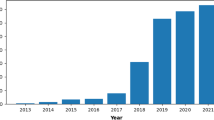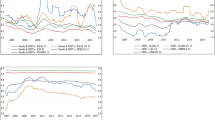Abstract
There is a significant interest in the growth and development of cryptocurrencies, the most notable ones being Bitcoin and Ripple. Global trading in these cryptocurrencies has led to highly speculative and “bubble-like” price movements. Since these cryptocurrencies trade like stocks, provide a feasible alternative to gold and appreciate during uncertain times, it can be hypothesized that their prices are partly determined by the global stock indices, gold prices, and fear gauges such as the VIX and the US Economic Policy Uncertainty Index. In this paper, we test this hypothesis by conducting a time series analysis of returns and volatilities of Bitcoin and of Ripple. We use the Autoregressive-moving-average model with exogenous inputs model (ARMAX), Generalized Autoregressive Conditionally Heteroscedastic (GARCH) model, Vector Autoregression (VAR) model, and Granger causality tests to determine linkages between returns and volatilities of Bitcoin and of Ripple. We find that the Bitcoin crash of 2018 could have been explained using these time series methods. We also find that returns of global stock markets and of gold do not have a causal effect on Bitcoin returns, but we do find returns on Ripple have a causal effect on Bitcoin prices.






Similar content being viewed by others
Notes
What is Bitcoin? https://Bitcoin.org/en/faq#what-is-Bitcoin
Blockchain by the numbers, https://www.blockchain.com/about/index.html
Bitcoin Market Capitalization, https://coinmarketcap.com/
Estimated USD transaction value, https://blockchain.info/charts/estimated-transaction-volume-usd
USD in circulation, https://fred.stlouisfed.org/series/WCURCIR
List of major cryptocurrencies by market capitalization, https://coinmarketcap.com/all/views/all/
BVOL computations, https://www.bitmex.com/app/index/.BVOL
Bitcoin (BTC) Prices, https://www.coindesk.com/price/bitcoin
Ripple (XRP) prices, https://www.coindesk.com/price/xrp
Gold historical data, https://www.gold.org/data/gold-price
BVOL computations, https://www.bitmex.com/app/index/.BVOL
VAR model order selection: https://sccn.ucsd.edu/wiki/Chapter_3.5._Model_order_selection
References
Alessandretti L, ElBahrawy A, Aiello LM, Baronchelli A (2018) Anticipating cryptocurrency prices using machine learning. Complexity 2018:1–16
Andersen T, Bollerslev T, Christoffersen PF, Diebold FX (2006) Volatility and correlation forecasting. Handbook of Economic Forecasting 1:777–878
Asteriou, D, and S Hall (2011). “Vector autoregressive (VAR) models and causality tests. Applied Econometrics.”
Baillie RT (1980) Predictions from ARMAX models. J Econ 12(3):365–374
Binsbergen V, Jules H, Koijen RSJ (2010) Predictive regressions: a present-value approach. J Financ 65(4):1439–1471
Bollerslev T (1986) Generalized autoregressive conditional heteroskedasticity. J Econ 31(3):307–327
Bouri E, Molnár P, Azzi G, Roubaud D, Hagfors LI (2017) On the hedge and safe haven properties of Bitcoin: is it really more than a diversifier? Financ Res Lett 20:192–198
Box, George EP, and Gwilym M Jenkins (1976). “Time Series Analysis: forecasting and control, rev. edn.” Holder-Day, San Francisco, CA, USA
Brooks, Chris (2014). Introductory econometrics for finance. Cambridge University Press, : 268–273
Brownlees C, Engle R, Kelly B (2011) A practical guide to volatility forecasting through calm and storm. The Journal of Risk 14(2):3–22
Campbell JY, Shiller RJ (1988) The dividend-price ratio and expectations of future dividends and discount factors. Rev Financ Stud 1(3):195–228
Catania, Leopoldo, Stefano Grassi, and Francesco Ravazzolo (2018). Predicting the Volatility of Cryptocurrency Time–Series. No. 3/2018. Centre for Applied Macro-and Petroleum economics (CAMP), BI. Norwegian Business School
Cheah E-T, Fry J (2015) Speculative bubbles in Bitcoin markets? An empirical investigation into the fundamental value of Bitcoin. Econ Lett 130:32–36
Cheah E-T, Mishra T, Parhi M, Zhang Z (2018) Long memory interdependency and inefficiency in Bitcoin markets. Econ Lett 167:18–25
Chu J, Chan S, Nadarajah S, Osterrieder J (2017) GARCH modelling of cryptocurrencies. Journal of Risk and Financial Management 10(4):17
Ciaian P, Rajcaniova M, Kancs d’A (2016) The economics of BitCoin price formation. Appl Econ 48(19):1799–1815
Cochrane JH (2007) The dog that did not bark: a defense of return predictability. Rev Financ Stud 21(4):1533–1575
Conti, Mauro, et al (2018). “A survey on security and privacy issues of bitcoin.” IEEE Commun Surv Tutorials
Dickey DA, Fuller WA (1979) Distribution of the estimators for autoregressive time series with a unit root. J Am Stat Assoc 74(366a):427–431
Dyhrberg AH (2016a) Bitcoin, gold and the dollar–a GARCH volatility analysis. Financ Res Lett 16:85–92
Dyhrberg AH (2016b) Hedging capabilities of bitcoin. Is it the virtual gold? Financ Res Lett 16:139–144
Engle, Robert F (1982). “Autoregressive conditional heteroscedasticity with estimates of the variance of United Kingdom inflation.” Econometrica: Journal of the Econometric Society : 987–1007
Engle R (2001) GARCH 101: the use of ARCH/GARCH models in applied econometrics. J Econ Perspect 15(4):157–168
Engle R (2002) Dynamic conditional correlation: a simple class of multivariate generalized autoregressive conditional heteroskedasticity models. J Bus Econ Stat 20(3):339–350
Estrada JCS (2017) Analyzing Bitcoin Price volatility. University of California, Berkeley
Fama EF, French KR (1988) Dividend yields and expected stock returns. J Financ Econ 22(1):3–25
Golez B, Koudijs P (2018) Four centuries of return predictability. J Financ Econ 127(2):248–263
Granger, Clive WJ (1969). “Investigating causal relations by econometric models and cross-spectral methods.” Econometrica: Journal of the Econometric Society : 424–438
Granger CWJ, Newbold P (1974) Spurious regressions in econometrics. J Econ 2(2):111–120
Guo, Tian, and Nino Antulov-Fantulin (2018). “Predicting short-term Bitcoin price fluctuations from buy and sell orders.” arXiv preprint arXiv:1802.04065
Hamilton JD (1994) Time series analysis. Vol. 2. Princeton Press, New Jersey
Hansen PR, Lunde A (2005) A forecast comparison of volatility models: does anything beat a GARCH (1, 1)? J Appl Econ 20(7):873–889
Johansen S (1991) Estimation and hypothesis testing of cointegration vectors in Gaussian vector autoregressive models. Econometrica 59:1551–1580
Katsiampa P (2017) Volatility estimation for Bitcoin: a comparison of GARCH models. Econ Lett 158:3–6
Klein T, Thu HP, Walther T (2018) Bitcoin is not the new gold–a comparison of volatility, correlation, and portfolio performance. Int Rev Financ Anal 59:105–116
Liu, Yukun, and Aleh Tsyvinski (2018). Risks and returns of cryptocurrency. No. w24877. National Bureau of Economic Research
Lux T, Marchesi M (2000) Volatility clustering in financial markets: a microsimulation of interacting agents. International Journal of Theoretical and Applied Finance 3(04):675–702
Malladi R, Dheeriya P, Martinez J (2019) Predicting Bitcoin return and volatility using gold and the stock market. Quarterly Review of Business Disciplines 5(4):357–373
McNally, Sean, Jason Roche, and Simon Caton (2018). “Predicting the price of bitcoin using machine learning.” 2018 26th Euromicro International Conference on Parallel, Distributed and Network-based Processing (PDP). IEEE
Munim ZH, Shakil MH, Alon I (2019) Next-Day Bitcoin Price Forecast. Journal of Risk and Financial Management 12.2:103
Nakamoto, Satoshi (2008). “Bitcoin: a peer-to-peer electronic cash system.” http://Bitcoin.org/Bitcoin.pdf
Narayanan, Arvind, et al (2016). Bitcoin and cryptocurrency technologies: a comprehensive introduction. Princeton University Press
Noga B (2018) Traditional and modern forms of money: euro and bitcoin. Czech Journal of Social Sciences Business and Economics 3:22–30
Peter, Ďurka, and Pastoreková Silvia (2012). “ARIMA vs. ARIMAX–which approach is better to analyze and forecast macroeconomic time series.” Proceedings of 30th International Conference Mathematical Methods in Economics. Karviná, Czech Republic
Poon S-H, Granger CWJ (2003) Forecasting volatility in financial markets: a review. J Econ Lit 41(2):478–539
Satchell, Stephen, and John Knight (2011). Forecasting volatility in the financial markets. Elsevier
Sims, Christopher A (1980). “Macroeconomics and reality.” Econometrica : 1–48
Taylor SJ (1987) Forecasting the volatility of currency exchange rates. Int J Forecast 3(1):159–170
Tschorsch F, Scheuermann B (2016) Bitcoin and beyond: a technical survey on decentralized digital currencies. IEEE Communications Surveys & Tutorials 18(3):2084–2123
Van Wijk, Dennis (2013). “What can be expected from the BitCoin.” Erasmus Universiteit Rotterdam
Acknowledgement
We thank Pallavi Malladi for providing us with research and editorial support.
Author information
Authors and Affiliations
Corresponding author
Additional information
Publisher’s note
Springer Nature remains neutral with regard to jurisdictional claims in published maps and institutional affiliations.
Rama K. Malladi is with California State University, Dominguez Hills, in California. He is a CFA Charter holder and a past president of the CFA Society Los Angeles.
Prakash L. Dheeriya is with California State University, Dominguez Hills, in California. He is a past chair of the Department of Finance.
Rights and permissions
About this article
Cite this article
Malladi, R.K., Dheeriya, P.L. Time series analysis of Cryptocurrency returns and volatilities. J Econ Finan 45, 75–94 (2021). https://doi.org/10.1007/s12197-020-09526-4
Accepted:
Published:
Issue Date:
DOI: https://doi.org/10.1007/s12197-020-09526-4
Keywords
- Asset management
- Alternative investments
- Digital currency
- Cryptocurrency
- Bitcoin, ripple, BTC, XRP, economic uncertainty index




